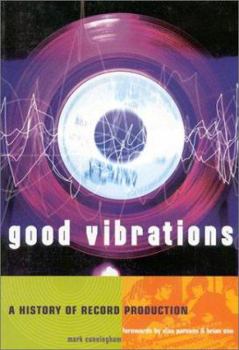Good Vibrations, Second Edition: A History of Record Production
Select Format
Select Condition 
Book Overview
A blend of the creative, the human and the technical, this book chronicles the development, decade by decade, of record production. Leading artists recall their earliest encounters with the recording... This description may be from another edition of this product.
Format:Paperback
Language:English
ISBN:1860742424
ISBN13:9781860742422
Release Date:September 1999
Publisher:Alfred Publishing Company
Length:438 Pages
Weight:1.41 lbs.
Dimensions:1.1" x 5.8" x 8.3"
Customer Reviews
5 ratings
A worthwhile read
Published by Thriftbooks.com User , 22 years ago
This book is a well-written history of record production. I was impressed at the amount of content for the price. The writing style is solid and enjoyable. Some Americans might find that too much focus is on British record production.
An Awsome Record History and Production!
Published by Thriftbooks.com User , 23 years ago
This book is truely an amazing work. It covers so so very much in history of Production and it covers not only whom, what, where but with all the microphones used, names of studios, artists and time, and what happened behind closed doors and why, and so very much more. I highly suggest this to anyone going into recording and into anyone with a love for music. It tells you all the things you want to know!!
Awfully Anglo -- but still worth a read.
Published by Thriftbooks.com User , 23 years ago
Like most reviewers here, I agree that this book is a bit unballanced. It is indeed biased to rock/pop. More so, though, it is biased to British rock/pop. Very little is said about US record production except when various Brit producers head to the US to "learn American tricks". Uhhhh... like what, exactly, guys? Nonetheless, this book is full of great info about the (very influential) Anglo music scene. More than anything else, it chronicals the increasing influence of studio technology on the way music is made and the rise of the studio itself as a musical instrument, and not simply as a passive tool for recording music.
A Fascinating Journey to the World of Record Production
Published by Thriftbooks.com User , 24 years ago
First of all, I'd like to share a few comments about the previous reviews. Although I agree this book is really geared towards the rock/pop scene, I do believe the bias is justified. Even today, classical and jazz recording techniques don't really employ the more radical innovations in production approach generated by the demands of rock/pop projects. Let's remember that multitrack classical recordings are a relatively new thing (The Zappa LSO recordings in the 80s are a fine example), and moreover, the role of the record producer is not so proeminent in such enterprises. Also, another complain points to the greater coverage of the UK scene. The book deals with the early days of multitrack recordings (Les Paul), then moves on to Phil Spector's 'wall of sound', Motown, Muscle Shoals and stops at Brian Wilson's efforts. Of course it's an incomplete US panorama, but then again the book does justice to important (and sometimes overlooked) names of the trade, like Joe Meek, Gus Dudgeon, Tony Visconti and David Hentschel. The idea of centering the chapters around a particular studio is nothing short of brilliant, giving the author the opportunity to comment on the evolution of recording technology and techniques, generated by the demands of their particular clients. Another fine addition to this book (in comparision to Buskin's book 'Inside Tracks') is the abundance of historic photographs and the presence of 'real-life' cases, where a particular producer shows the approach he used to achieve a particular result. Add a wealth of anecdotes and behind-the-scenes stuff aplenty and you get a sure winner.
THE book on the real history of hit making
Published by Thriftbooks.com User , 25 years ago
There are two basic types of music fans: (1) people who like to read quotes from the members of Pink Floyd explaining how they actually put together their records and (2) people who think Pink Floyd are, whoa, a trip. People in the first category will love this book. Unlike other similar books, this is an actual history of record production in chronological order. Cunningham is a talented writer. He's also a respected producer and player himself, which means he knows just about everyone who is anyone behind the scenes of record making, and they all seem to have agreed to talk to him! The book is worth buying just for all the little anecdotes, such as the time the trumpet soloist on "Penny Lane" inadvertently offended John Lennon at the session, or the time one of the world's top producers, Chris Thomas, was beat up by thugs while recording the Sex Pistols. But it's also full of important, hard facts. The section on Motown, for example, cuts through all the usual mythology about everything being recorded in Detroit, and provides quote after quote from actual participants explaining how Los Angeles session musicians (Carol Kaye, Earl Palmer, Hal Blaine, etc.) played on many of the biggest mid-'60s Motown hits. That's typical of the book: Cunningham does his homework. While most writers have a hard time even explaining what a Mellotron is, he gives a detailed history of the instrument, and its use on particular hit records, and provides an interesting quote from George Martin about the instrument, and figures out where the actual Mellotron the Beatles used on "Strawberry Fields Forever" is today. This is not the sort of simplistic hero-worship PR that entertains the average person in the average magazine. It's a thick, accurate, intelligent book, full of authentic, little-known stories, told from the inside, and they're fascinating.






